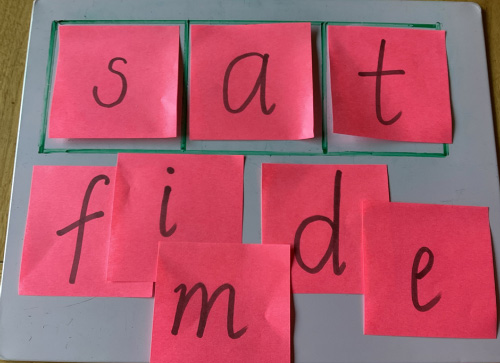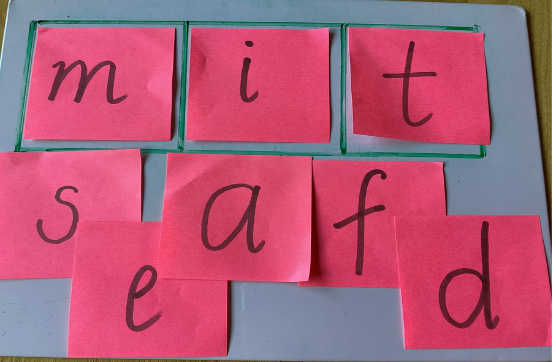Lesson overview
Deleting and manipulating sounds is the most complex of phonemic awareness skills positioned last on the phonological awareness continuum (Schuele & Boudreau, 2008). Phonemic awareness is an aural skill which involves the identification, segmentation and manipulation of sounds (phonemes) within words. Research argues phonemic awareness instruction in conjunction with the teaching of phonics (sound to letter correspondences) benefits the development of both skills and positively contributes to learning to read (Kahn & Kahn, 2020).
In this lesson plan vowel sounds are represented by the international phonetic alphabet (IPA). You will find /æ/ represents the short vowel a sound as in ‘apple’ and ‘ant’, /ɛ/represents the short vowel e sound as in ‘edge’ and ‘fender’ and /ɪ/ represents the short vowel i sound as in ‘it’ and ‘lift’. Additionally, the IPA symbol /ð/ is used to distinguish the voiced ‘th’ sound in ‘this’ and ‘the’.
Victorian curriculum links
Level 1
Manipulate phonemes by addition, deletion and substitution of initial, medial and final phonemes to generate new words (VCELA204)
English as an Additional Language (EAL)
Pathway A: Early immersion
A1: Identify some sounds in words (VCEALL050)
A1: Recognise some common letters and letter patterns in words (VCEALL051)
A2: Identify and produce phonemes in blends and clusters at the beginning and end of syllables (VCEALL110)
A2: Use knowledge of letters and sounds to read a new word or locate key words (VCEALL132)
Learning intention
We are learning to delete and substitute sounds in words and match to letters to make new words that can be read and written down.
Success criteria
I can hear and name sounds in a word.
I can take away a sound and add another to make a new word.
I can match sounds to letters to make words I can read and write.
Resources required
- Enlarged copy of the traditional nursery rhyme: Humpty Dumpty
Humpty Dumpty sat on a wall.
Humpty Dumpty had a great fall.
All the king’s horses and all the king’s men
couldn’t put Humpty together again.
- Identified CVC words in Humpty Dumpty: sat, had, men, and
- Sticky notes
- Individual whiteboards
- Counters – 1x one colour and 2 x another. Enough for 3 counters per pair.
Group size (if relevant)
Whole class and/or small group
Lesson sequence
- The teacher introduces the learning intention and success criteria, then asks students to listen and watch carefully.Discuss to ensure understanding.
- Using modelled reading, read the enlarged nursery rhyme text to students. Use a pointer to reinforce concepts about print such as left to right, return sweep and word recognition.
- Using shared reading, reread the nursery rhyme encouraging students to join in on known sections of the text.
- Tap into prior knowledge: identify the consonant-vowel-consonant (CVC) words sat, had, and, men from the nursery rhyme. Explicitly model to students how to segment each word to hear and identify the 3 sounds in each word.
For example, say the word ‘sat’ and then segment the sounds /s/, /æ/, /t/. As the teacher segments, they might use their finger to tap the sounds on their arm/knee/or other body part.
- Ask students to turn and work with a partner to segment the sounds in the same 4 words. Encourage students to tap a body part as they identify and segment each phoneme. Students share with the group.
- Once accurate segmenting has been ascertained, the teacher uses the think aloud strategy to explicitly model how to delete a phoneme in sat, had, and, men and substitute with another phoneme. Start with replacing the initial or end sound and then the medial sound. This can be differentiated according to the student cohort, and students may take more than one session to be successful at an initial, final and medial deletion/substitution. Use a visual prompt such as coloured counters to represent where the phoneme will change. At this stage work with sounds only.
For example,
Initial sound: Say the word ‘and’ and then say “I am going to take away the /æ/ at the start of ‘and’ and replace it with /ɛ/. I can make a new word ‘end’.



Final sound: Say the word ‘had’ and then say “I am going to take away the last sound /d/ and replace it with /s/. I can make a new word ‘has’



Medial sound: Say the word ‘sat’ and then say “I am going to take away the middle sound /æ/ and replace it with /ɪ/. I can make a new word ‘sit’.



Students pair up and using the 4 modelled CVC words, practise deleting and substituting sounds using the counters. While students practise, the teacher roves the pairs to assist at point of need or to work intensively with a small group for further support. Multiple exposures to this aural skill is recommended.
Differentiation:
- At this point if CVC words prove difficult, modify using vowel-consonant (VC) words only (e.g. at→it, an→on, at→an).
- If some students find this task easy, ask them to suggest a CVC word to their partner and work out which sound they could delete and substitute to make a new word(e.g. car→cat→cut).
- Students return counters and move back to the main group. Return to the four CVC words identified in the Humpty Dumpty nursery rhyme (sat, had, and, men). Using Elkonin boxes and individual sticky notes with single letters written on each, model how to match sounds to letters to make a CVC word (e.g. The first sound in sat is /s/ and the letter that matches that sound is ‘s’. Place a sticky note with an ‘s’ in the first box. Repeat for remaining sounds and corresponding letters to make the CVC word ‘sat’.
Once students are confident with matching sounds to letters to make a given CVC word, add more letters and model how to delete and substitute sounds/letters to make new CVC words.


- Students work with a partner or small group to write given letters on sticky notes. Students draw 3 Elkonin boxes on a small whiteboard. Pairs make given CVC words and then delete and manipulate the sticky notes to make real and non -words. Students record words in their workbooks.
Differentiation:
- Provide pictures for students who are still working at hearing the initial sound only. Ask them to label and sort the pictures by the first sound. Match to a letter if possible.
- Use VC words with students who require more scaffolding.
- Extend some students by including consonant digraphs (sh, ch, ph, wh, th) on the sticky notes. For example, say the word ‘sat’ and then say “I am going to take away the first sound /s/ and replace it with /ð/. I can make a new word ‘that’.
- Make this a teacher led activity to explicitly teach and support individuals or small groups of students.
- Students return to the main group and share the words they made by deleting/substituting sounds and letters. Choose some students to articulate their learning. Link to the success criteria.
Going further
- Make a CVC word ladder. On each rung one letter must be deleted and substituted. Challenge students to try and build a ladder with as many rungs as possible. Students make the CVC words with magnetic letters so they can physically delete and substitute letters and then record on the ladder.
- Using a die net (available freely on the web), students record given consonants (e.g. s, t, m, g, d, l) on one die and vowels (a, e, i, o, u) on another to construct alphabet dice. Students take turns rolling the dice to make a CVC word which they record. A die in then thrown again, and an initial, medial or final letter is deleted (removed) and the new letter rolled on the die is substituted. Students record the new word, segment and blend. Accept both real or non -words.
References
Kahn, M. & Khan, R. (2021). Phonological Awareness and Phonics Instruction: Inclusive practice that benefits all kinds of learners. Asia Pacific Journal of Developmental Differences, 8(1), 173-185.
Schuele, C.M. & Boudreau, D. (2008). Phonological Awareness Intervention: Beyond the Basics. Language, Speech, and Hearing Services in Schools, Vol. 3, 3-20.